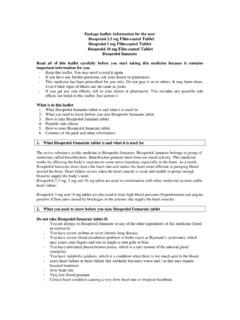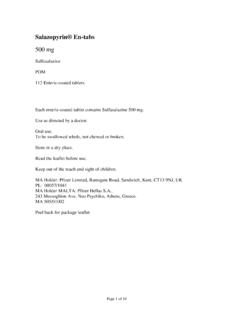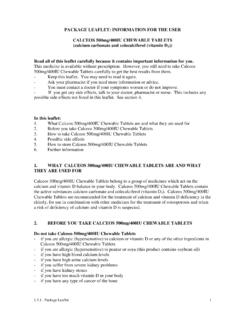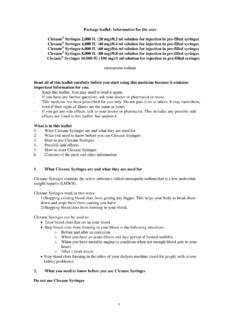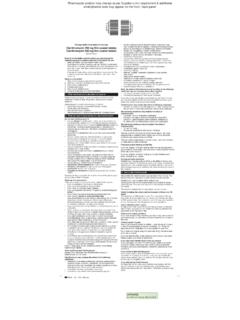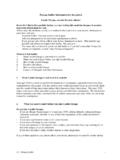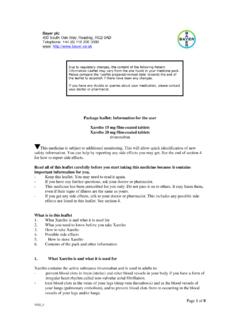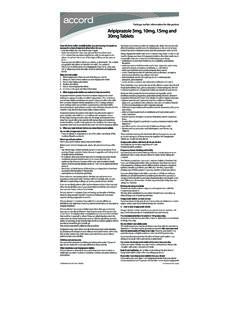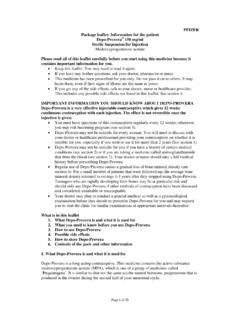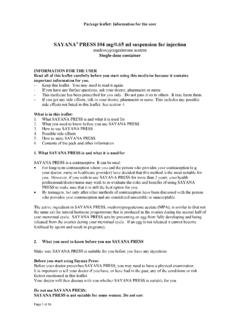Transcription of Co-amoxiclav 500 mg/125 mg film-coated tablets
1 Read all of this leaflet carefully before you start taking this medicine because it contains important information for this leaflet. You may need to read it you have any further questions, ask your doctor or medicine has been prescribed for you only. Do not pass it on to others. It may harm them, even if their signs of illness are the same as you get any side effects, talk to your doctor or pharmacist. This includes any possible side effects not listed in this leaflet. See section is in this Co-amoxiclav is and what it is used you need to know before you take to take side to store of the pack and other informationCo- amoxiclav is an antibiotic and works by killing bacteria that cause infections. It contains two different medicines called amoxicillin and clavulanic acid.
2 Amoxicillin belongs to a group of medicines called penicillins that can sometimes be stopped from working (made inactive). The other active component (clavulanic acid) stops this from is used in adults and children to treat the following infections: middle ear and sinus infections respiratory tract infections urinary tract infections skin and soft tissue infections including dental infections bone and joint not take Co-amoxiclav if you are allergic to amoxicillin, clavulanic acid, penicillins or any of the other ingredients of this medicine (listed in section 6) if you have ever had a severe allergic (hypersensitive) reaction to any other antibiotic. This can include a skin rash or swelling of the face or neck if you have ever had liver problems or jaundice (yellowing of the skin) when taking an antibiotic.
3 Do not take Co-amoxiclav if any of the above apply to you. If you are not sure, talk to your doctor or pharmacist before taking and precautions Talk to your doctor or pharmacist before taking Co-amoxiclav if you: have glandular fever are being treated for liver or kidney problems are not passing water regularlyIf you are not sure if any of the above apply to you, talk to your doctor or pharmacist before taking some cases, your doctor may investigate the type of bacteria that is causing your on the results, you may be given a different strength of Co-amoxiclav or a different you need to look out forCo- amoxiclav can make some existing conditions worse, or cause serious side effects. These include allergic reactions, convulsions (fits) and inflammation of the large intestine.
4 You must look out for certain symptoms while you are taking Co-amoxiclav , to reduce the risk of any problems. See Conditions you need to look out for in section and urine testsIf you are having blood tests (such as red blood cell status tests or liver function tests) or urine tests (for glucose), let the doctor or nurse know that you are taking Co-amoxiclav . This is because Co-amoxiclav can affect the results of these types of medicines and Co-amoxiclavTell your doctor if you are taking, have recently taken or might take any other you are taking allopurinol (used for gout) with Co-amoxiclav , it may be more likely that you will have an allergic skin reaction. Co-amoxiclav is and what it is used for you need to know before you take Co-amoxiclavIf you are taking probenecid (used for gout), your doctor may decide to adjust your dose of medicines to help stop blood clots (such as warfarin) are taken with Co-amoxiclav then extra blood tests may be can affect how methotrexate (a medicine used to treat cancer or rheumatic diseases) can affect how mycophenolate mofetil (a medicine used to prevent the rejection of new organs following a transplant operation)
5 , breast-feeding and fertilityIf you are pregnant or breast-feeding, think you may be pregnant or are planning to have a your doctor or pharmacist for advice before taking this and using machinesCo- amoxiclav can have side effects and the symptoms may make you unfit to drive. Don t drive or operate machinery unless you are feeling take this medicine exactly as your doctor has told you. Check with your doctor or pharmacist if you are not and children weighing 40 kg and overThe recommended dose is: 1 tablet three times a dayChildren weighing less than 40 kgChildren aged 6 years or less should preferably be treated with amoxicillin/clavulanic acid oral suspension or your doctor or pharmacist for advice when giving Co-amoxiclav tablets to children weighing less than 40 kg.
6 Children may be treated with Co-amoxiclav tablets , suspensions or paediatric with kidney and liver problems If you have kidney problems the dose might be changed. A different strength or a different medicine may be chosen by your doctor. If you have liver problems you may have more frequent blood tests to check how your liver is to take Co-amoxiclav Swallow the tablets whole with a glass of water at the start of a meal or slightly before tablets can be broken along the score line to make them easier to swallow. You must take both pieces of the tablet at the same time. Space the doses evenly during the day, at least 4 hours apart. Do not take 2 doses in 1 hour. Do not take Co-amoxiclav for more than 2 weeks. If you still feel unwell you should go back to see the you take more Co-amoxiclav than you shouldIf you take too much Amoxicillin/Clavulanic acid, signs might include an upset stomach (feeling sick, being sick or diarrhoea) or convulsions.
7 Talk to your doctor as soon as possible. Take this medicine carton to show the you forget to take Co-amoxiclav If you forget to take a dose, take it as soon as you remember. You should not take the next dose too soon, but wait about 4 hours before taking the next dose. Do not take a double dose to make up for a forgotten you stop taking Co-amoxiclav Keep taking Co-amoxiclav until the treatment is finished, even if you feel better. You need every dose to help fight the infection. If some bacteria survive they can cause the infection to come you have any further questions on the use of this medicine, ask your doctor or all medicines, this medicine can cause side effects, although not everybody gets you need to look out for Allergic reactions: skin rash inflammation of blood vessels (vasculitis) which may be visible as red or purple raised spots on the skin, but can affect other parts of the body fever, joint pain, swollen glands in the neck, armpit or groin Swelling, sometimes of the face or mouth (angioedema), causing difficulty in breathing Collapse.
8 Allergic acute cardiac syndrome (kounis syndrome) Contact a doctor immediately if you get any of these symptoms. Stop taking Co-amoxiclav . to take Co-amoxiclav side effectsPackage leaflet: Information for the userCo- amoxiclav 500 mg/125 mg film - coated tablets (Amoxicillin/Clavulanic acid)195 x 380 mmBlackAdditional Information : Supersede Itemcode: P1510534 Team LeaderArjunInitiatorArief Co-amoxiclavProduct NameCustomer / CountryUK_MaltaDimensions195 x 380 mmPharmacode12165 Component03 LeafletVersion Of IssueRevisionP1512165 Item CodeReviewed / Approved byDate & & 3:00 pmSign / DateColoursArtist:No of Colours : 01P1512165 Inflammation of large intestineInflammation of the large intestine, causing watery diarrhoea usually with blood and mucus, stomach pain and/or fever.
9 Contact your doctor as soon as possible for advice if you get these common side effectsThese may affect more than 1 in 10 people diarrhoea (in adults).Common side effectsThese may affect up to 1 in 10 people thrush (candida a yeast infection of the vagina, mouth or skin folds) feeling sick (nausea), especially when taking high doses if affected take Co-amoxiclav before food vomiting diarrhoea (in children)Uncommon side effectsThese may affect up to 1 in 100 people skin rash, itching raised itchy rash (hives) indigestion dizziness headacheUncommon side effects that may show up in your blood tests: increase in some substances (enzymes) produced by the side effectsThese may affect up to 1 in 1000 people skin rash, which may blister, and looks like small targets (central dark spots surrounded by a paler area, with a dark ring around the edge erythema multiforme) if you notice any of these symptoms contact a doctor side effects that may show up in your blood tests.
10 Low number of cells involved in blood clotting low number of white blood known side effectsFrequency cannot be estimated from the available data Allergic reactions (see above) Inflammation of the large intestine (see above) Inflammation of the layers lining the brain and spinal cord called meninges (aseptic meningitis) Inflammation of the bile tube (cholangitis) allergic acute cardiac syndrome (kounis syndrome) Serious skin reactions:-a widespread rash with blisters and peeling skin, particularly around the mouth, nose, eyes and genitals (Stevens-Johnson syndrome), and a more severe form, causing extensive peeling of the skin (more than 30% of the body surface toxic epidermal necrolysis)-Widespread red skin rash with small pus-containing blisters (buloous exfoliative dermatitis)-a red, scaly rash with bumps under the skin and blisters (exanthemous pustulosis).
